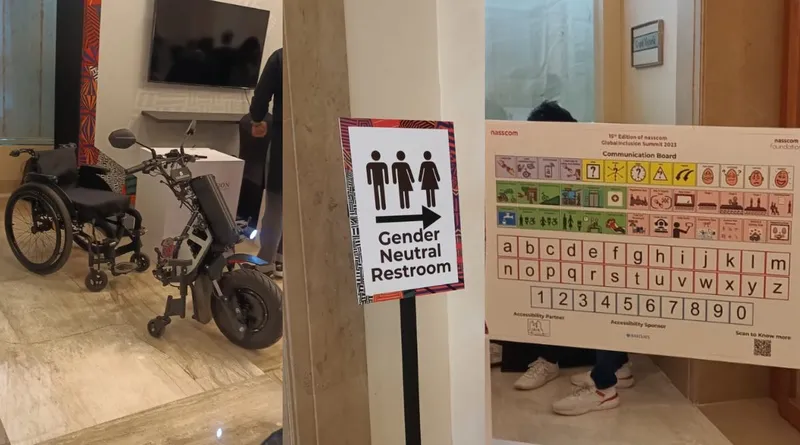Real-world actions lie at the heart of inclusivity: 15th NASSCOM Global Inclusion Summit
The 15th NASSCOM Global Inclusion Summit addressed subjects such as the inclusion of people with disabilities, the LGBTQIA+ community, and women, among other marginalised groups, in the workplace and society.
With the presence of gender-neutral washrooms, sign communication boards, and a diverse representation of people from the LGBTQIA+ community, women, and people with disabilities, the 15th NASSCOM Global Inclusion Summit exemplified the true spirit of inclusiveness.
Hosted by NASSCOM and NASSCOM Foundation, the event was focused on the theme, 'Real-World Actions for Mainstreaming Inclusion'. The two-day-long summit, which saw over 600 delegates and 37 speakers, concluded in Bengaluru on June 28.
The event featured keynotes, multiple workshops and masterclasses addressing subjects such as the inclusion of people with disabilities, the LGBTQIA+ community, and women among other marginalised groups in the workplace and society.
“Inclusion is no more a buzzword. It is something that requires us to step beyond just conversation. In this era, we believe in actionable inclusion, fostering an environment where everyone thrives. At the 15th edition of the NASSCOM Global Inclusion Summit, our efforts are firmly focused on achieving this transformative goal and strengthening it further by underlining the need for Real World Actions for mainstreaming inclusion,” said Nidhi Bhasin, CEO of the foundation.

Nidhi Bhasin, CEO of the Nasscom Foundation
Understanding inclusivity and diversity
As the Cambridge Dictionary puts it, 'inclusivity' means including all types of people, things or ideas and treating them all fairly and equally. According to the experts on the panel, inclusivity is a multi-faceted concept. It means that it can have multiple forms such as inclusivity of gender, ideas, and more.
“When we talk about inclusivity, highlighting the differences should not be the focus,” said Dr Ritu Anand, Senior Vice President at Tata Consultancy Services who also spearheads TCS' Workplace Diversity initiative.
She added that the focus should be on career growth and not who the person is and what they identify with. You must ask the employee in what position they see themselves in a few years hence and what specific resources they might need to achieve that goal, she advised.

Promoting inclusivity
Organisational decisions must be implemented after understanding what the employees need and not what the organisation thinks is right for them, Dr Anand noted.
In a lighter vein, she explained a woman in her family way or one having any social obligations might prefer working from home for maybe a few coming years but she might feel differently about it after that phase has passed. Just because she wants a hybrid setup now, it doesn't mean that she will want to stay at home for the next 40 years. The idea is to understand the employees’ needs in the present situation. Preferences and needs can change, hence flexibility is crucial to inclusivity.
She also underlined that inclusivity and diversity go hand in hand. “Similarity breeds similarity,” Anand says. Therefore while making organisational teams one should be open to different ideas, perspectives and a diverse cultural workforce, she noted.
In the same vein, Rostow Ravanan, Chairman and CEO of Alfahive Inc and Chairperson, NASSCOM Foundation, said that “diversity is the torso which cannot walk without equity and inclusivity.”
However, he clarified that equity must not be confused with equality. While equality means that an individual or a group of people are offered the same resources or opportunities, equity recognises that each person has different circumstances and the resources should be allocated as per the need of the person.
However, Bhasin said that noteworthy achievements have been made in cultivating inclusive spaces but still a lot needs to be done. Ravanan agreed that many organisations have started adopting inclusivity in various forms. “Many companies have made it their ethos to inculcate neutral job descriptions and have proper employee grievance systems in place. This culture fosters inclusivity and safety,” he added.
Action-based approach to promote inclusivity
The theme of the summit focused on going beyond conversation and exercising strategic implementation of inclusivity at various organisation levels. As such, the panellists talked about various strategies that could foster inclusivity:
- The concept of inclusivity must begin at the leadership level. Forming practical strategies and their successful implementation should be the way forward to creating inclusive spaces.
- Organisations that have successfully inculcated the spirit of inclusivity have understood the concept comprehensively and not as a single entity.
- Create platforms in organisations where diverse voices can be heard.
- Create a conversation about the needs of the marginalised communities outside the workspace, in social settings, with family and as a part of primary education to promote sensitisation and acceptance.
- Enable women to continue thriving in their careers by framing flexible policies that are sensitive to social obligations such as marriage, maternity breaks, and others. Additionally, offer them upskilling opportunities.
Edited by Kanishk Singh








